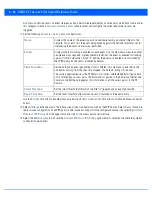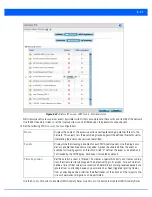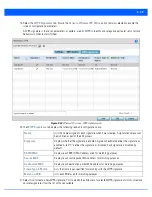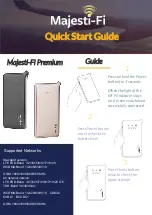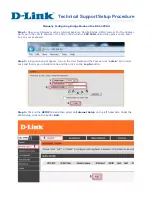
9 - 6
WiNG 5.7.1 Access Point System Reference Guide
9. Set the following
Client Settings
to define the duration clients are allowed captive portal access and when they’re timed
out due to inactivity:
10. Use the
DNS White List
drop-down menu to use a set of allowed destination IP addresses for the captive portal. These
allowed DNS destination IP addresses are called a
Whitelist
. If no whitelist entry exists with the correct set of IP addresses,
select the
Create
icon (to the right of the drop-down menu) and define a new whitelist. For more information, see
the DNS Whitelist Configuration on page 9-13
Each supported access point model can support up to 32 whitelists, with the exception of AP6511 and AP6521 models
which can only support up to 16 whitelists.
To effectively host captive portal pages on an external Web server, the IP address of the destination Web server(s) should
be in the whitelist.
Refer to the drop-down menu of existing
DNS White List
entries to select a policy to be applied to this captive portal
policy.
a. If creating a new whitelist, assign it a name up to 32 characters. Use the
+ Add Row
button to populate the whitelist
table with Host and IP Index parameters that must be defined for each whitelist entry.
Figure 9-3
Captive Portal DNS Whitelist screen
b. Provide a numerical IP address or Hostname within the
DNS Entry
parameter for each destination IP address or host in
the whitelist. A valid hostname cannot contain an underscore.
c. Use the
Match Suffix
parameter to match any hostname or domain name as a suffix. The default setting is disabled.
RADIUS VLAN
Assignment
Select this option to enable the RADIUS server to assign a VLAN post authentication.
Once a captive portal user is authenticated, the user is assigned the VLAN as configured
in the
Post Authentication VLAN
field.
Post Authentication
VLAN
Use the spinner control to define the VLAN that a captive portal user is assigned once
authenticated by a RADIUS server.
Client Access Time
Use the spinner control to define the duration wireless clients are allowed access to the
network using the captive portal policy. Set an interval from 30 - 10,800 minutes. The
default interval is 1,440 minutes.
Inactivity Timeout
Use the drop-down menu to specify an interval in either
Minutes
(5 - 30) or
Seconds
(300
- 1,800) that, when exceeded, times out clients that have not transmitted a packet within
the captive portal.
Summary of Contents for WiNG 5.7.1
Page 1: ...WiNG 5 7 1 ACCESS POINT SYSTEM REFERENCE GUIDE ...
Page 2: ......
Page 3: ...WING 5 7 1 ACCESS POINT SYSTEM REFERENCE GUIDE MN001977A01 Revision A April 2015 ...
Page 4: ...ii WiNG 5 7 1 Access Point System Reference Guide ...
Page 24: ...1 4 WiNG 5 7 1 Access Point System Reference Guide ...
Page 36: ...2 12 WiNG 5 7 1 Access Point System Reference Guide ...
Page 72: ...3 36 WiNG 5 7 1 Access Point System Reference Guide ...
Page 470: ...5 386 WiNG 5 7 1 Access Point System Reference Guide ...
Page 472: ...6 2 WiNG 5 7 1 Access Point System Reference Guide Figure 6 1 Configuration Wireless menu ...
Page 624: ...7 46 WiNG 5 7 1 Access Point System Reference Guide ...
Page 724: ...9 56 WiNG 5 7 1 Access Point System Reference Guide ...
Page 783: ...12 35 Figure 12 46 Device Summary screen 4 Click File Management ...
Page 816: ...12 68 WiNG 5 7 1 Access Point System Reference Guide ...
Page 1006: ...13 190 WiNG 5 7 1 Access Point System Reference Guide ...
Page 1026: ...14 20 WiNG 5 7 1 Access Point System Reference Guide ...
Page 1028: ...A 2 WiNG 5 7 1 Access Point System Reference Guide ...
Page 1089: ......
Page 1090: ...MN001977A01 Revision A April 2015 ...

